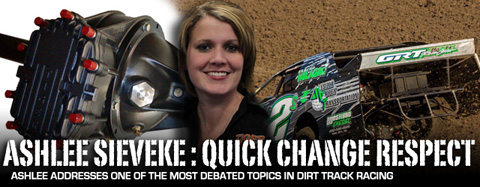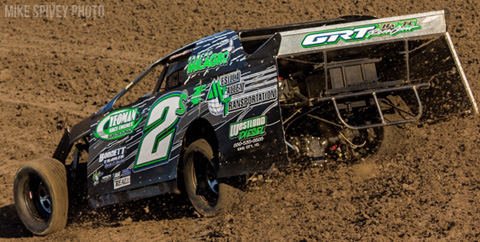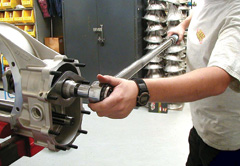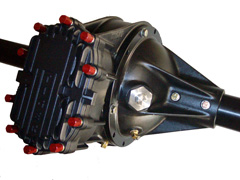Why doesn’t the quick change get any respect?

When tackling the “Quick Change Rear End” debate in short track racing, you will find that there are a variety of opinions, especially regarding whether they are hurting or helping the affordability and continued growth of the sport. While some think the quick change is the root of all evil in some divisions of short track racing, it may in all actuality be one of the innovations that grow the sport.
Benefits Versus The 9-Inch
The most obvious advantage of having a quick change is in the name: it’s quick. While changing a Ford 9-inch gear can take one person up to an hour to change, the quick change rear end makes it possible to complete the gear change within minutes.
The main benefits of the quick change are not exactly performance related, but instead the convenience and cost savings. For example, when WISSOTA made the decision to allow quick changes in the Modified class in 2011, Kevin ‘Buzzy’ Adams chose to stick with the Ford 9-inch. Adams continued on to with the WISSOTA National Championship before switching to a quick change for the 2012 season.

The choice was not due to the idea of a performance advantage over the Ford 9-inch, but instead saving time each night to change gears before the next race, the space he saved by replacing upwards of ten gear ratios with quick change gears, and the money saved after the initial investment in the quick change.
Recently, I read a piece on Dirt Modified racing in which one sanctioning body representative made a statement about quick changes. He felt that the Modified division was not designed to be a touring class, and instead a local racing class. Even the ‘local’ division competes for National points in some circumstances and the quick change makes traveling to support different sanctioned tracks within the region easier.
Allowing the quick change rear end does not mean that those who travel less or are satisfied with the Ford 9-inch must invest in a quick change. For the racer that doesn’t travel, the Ford 9-inch rear end is a great fit for their racing program, especially if they already own the equipment.
On the other hand, the cost of the Ford 9-inch gears may limit travel to even a local track miles down the road. For a low budget driver hoping to compete at different tracks throughout the weekend, the Ford-9 inch may limit the travel he/she does based on the fact they do not have the correct gear or time to complete the gear change. The introduction of a quick change has benefits for both the local and traveling team, as the quick change option is much more affordable after the initial investment.
Do Performance Products Promote Affordable Racing?
Back in October, powerTV’s Senior Tech Editor, Bobby Kimbrough specifically addressed the issue of affordable racing on OneDirt.com. In this feature, track promoter Royal Jones, who is a racer himself, explained one of the benefits that many overlook when debating between a Ford 9-inch rear end over a quick change. A racer is simply not going to make a gear change in the pits with a Ford 9 inch type rear end. This can lead to a guy running the improper gear at the track and blowing up his motor. After allowing the quick change rear ends at his tracks, Jones says, “We don’t blow up too many motors around here anymore. You tell me which is cheaper in the long run.”
This can lead to a guy running the improper gear at the track and blowing up his motor. After allowing the quick change rear ends at his tracks, Jones says, “We don’t blow up too many motors around here anymore. You tell me which is cheaper in the long run.”
Another point that Jones brought up for consideration was race damage. A quick change rear end is a part that is made for racing and as such, they have replaceable components for race damage repair. If you bend an axle tube, it is easy and cost affordable to buy a new axle tube rather than buying an entire stock housing. According to Jones, that is the difference between parts that are made for racing, and stock parts that are adapted for racing use.
The affordability of replacement parts and overall durability of the quick change is what makes this performance piece attractive to the racer. Quick change manufacturers like Tiger Rear Ends pride themselves on this durability, as they themselves are racers. The resilience is proven, as quick changes routinely make their way in for their first rebuild after years of competition without any issues-although I would not suggest skipping proper maintenance!
They themselves have heard the concerns from the racers concerning the cost of switching from a Ford 9-inch to the quick change. One of the arguments is the cost of the options available with the quick change that would in their minds drastically increase the cost to the racer.
Costs
While it is possible to purchase a brand new complete standard quick change for under $1,500, racers can purchase a new American manufactured and assembled low drag quick change for a Dirt Modified from Tiger complete with a magnesium center, aluminum six rib bells, steel GN 2½” tubes, HD rear cover and HD bearings, heat treated jackshaft, aluminum spool, low drag angular contact pinion bearing, low drag yoke and carrier seals, REM finished ring and pinion and bearings, aluminum posi-lock assembly, (and with the additional EDM lightening of the ring gear, and a tube seal options), for under $2,000.00 retail. This includes all the popular performance enhancing options that are just that-optional.
Racers can purchase new quick change gears for under $75 a set, and can store a complete set in a small fraction of the space required with the Ford 9-inch. In comparison, a competitor can purchase a new 9-inch rear end housing for under $400, but the gear ratios have the potential of costing over $500 a piece.
People tend to forget that the racers with more funding will outspend the smaller budget teams, and there are those who will pay to get the advantage regardless of the rules that are in place. The affordability of a quick change and the gears actually level the playing field by allowing the smaller budget teams to purchase the gears they need to compete at both the local tracks or a new track that they may not have visited because they did not have the correct gear or the funds to invest into the gear needed just to attend a new track.
The affordability of a quick change and the gears actually level the playing field by allowing the smaller budget teams to purchase the gears they need to compete at both the local tracks or a new track that they may not have visited because they did not have the correct gear or the funds to invest into the gear needed just to attend a new track.
For example, there is also a variety of performance enhancing options for the Ford 9-inch gears. REM polishing of the ring and pinion alone can cost upwards of $150 each, in addition to the $150 or more to lighten the gear. The low budget teams may not have the funds to purchase gears with these options, putting the teams with multiple gear sets and lightened gears at an advantage.
Another opinion is that the market will become over-saturated with Ford 9-inch rear ends and will leave teams with equipment that they have invested money in because the technology is outdated. I do not believe this is the case. Ford 9-inch rear ends have been used for years in short track racing, and even though there has been an increased interest in quick change rear ends, the demand for Ford 9-inch will not go away.
As the sport evolves, the decision of what rear end is utilized should be based on what is best for the team. Luckily for the racers, sanctioning bodies and the industry are starting to give quick changes the respect they deserve in Dirt racing.



.jpg)


.jpg)
.jpg)

.jpg)


.jpg)